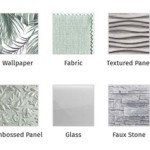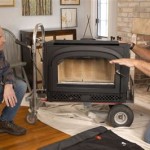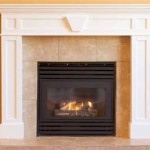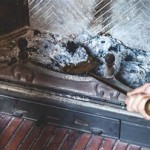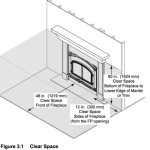Gas Inserts: Revitalizing Existing Fireplaces
The decision to enhance an existing fireplace is a common one for homeowners. While traditional wood-burning fireplaces offer a certain rustic charm, they can also be inefficient, require substantial upkeep, and contribute to indoor air pollution. Gas inserts provide a compelling alternative, offering the aesthetic appeal of a fire with increased convenience, efficiency, and environmental responsibility. A gas insert is essentially a self-contained unit that fits directly into the firebox of an existing masonry or factory-built fireplace. It burns natural gas or propane to generate heat, offering a controllable and cleaner-burning alternative to wood.
The process of installing a gas insert typically involves several steps. First, the dimensions of the existing fireplace opening are meticulously measured to ensure a proper fit. This measurement is crucial, as a gas insert must be appropriately sized for the firebox to function safely and efficiently. Next, a gas line must be run to the fireplace, requiring the expertise of a qualified gas fitter. The existing chimney is then inspected to ensure it is in good condition and properly sized for the gas insert. In many cases, a stainless steel liner is installed within the chimney to provide a dedicated flue for the gas insert's exhaust. This liner prevents corrosive gases from damaging the existing masonry and ensures proper venting of combustion byproducts. Finally, the gas insert is installed, connected to the gas line, and tested for proper operation. This entire process typically requires professional installation to ensure adherence to local building codes and safety regulations.
Key Point 1: Enhanced Efficiency and Cost Savings
One of the primary advantages of gas inserts is their significantly improved energy efficiency compared to traditional wood-burning fireplaces. Open fireplaces are notoriously inefficient, with much of the heat generated escaping up the chimney. Gas inserts, on the other hand, are designed to radiate heat into the room, significantly reducing heat loss. Many modern gas inserts boast efficiency ratings of 70% or higher, meaning that a greater proportion of the fuel's energy is converted into usable heat. This improved efficiency translates directly into cost savings on heating bills, particularly during colder months. A gas insert can effectively heat a specific room or zone, reducing the need to rely solely on a central heating system. This zonal heating approach can lead to significant savings over time.
The precise cost savings depend on several factors, including the efficiency of the gas insert, the local price of natural gas or propane, and the frequency of use. However, by reducing reliance on a whole-house heating system, a gas insert can contribute to substantial savings on energy consumption. Furthermore, some gas inserts are equipped with features such as thermostats and programmable timers, allowing for even greater control over heating output and energy consumption. These features enable homeowners to optimize the use of the gas insert, further maximizing energy savings and minimizing waste.
Beyond the direct cost savings on energy bills, gas inserts also offer indirect financial benefits. Because they burn cleaner than wood, they produce less creosote, a flammable substance that can accumulate in the chimney. Reduced creosote buildup translates to less frequent chimney cleanings, saving homeowners time and money on maintenance. Moreover, by reducing reliance on wood as a fuel source, gas inserts can help to mitigate the costs associated with purchasing, storing, and handling firewood. These factors, combined with the improved energy efficiency, make gas inserts a financially sound investment for many homeowners.
Key Point 2: Convenience and Ease of Use
Another significant advantage of gas inserts is their convenience and ease of use compared to traditional wood-burning fireplaces. Unlike wood fireplaces, gas inserts require no manual labor to start or maintain a fire. With the simple push of a button or flick of a switch, a gas insert can be ignited, providing instant warmth and ambiance. There is no need to gather, chop, stack, or transport firewood, eliminating a significant amount of physical effort and time commitment. Furthermore, gas inserts eliminate the mess and inconvenience associated with wood-burning fireplaces, such as ash cleanup and wood debris.
The convenience of gas inserts extends beyond the ease of starting and maintaining a fire. Many models are equipped with features such as remote controls, thermostats, and programmable timers, allowing for precise control over the flame height, heat output, and operating schedule. These features enable homeowners to customize the fire to their specific needs and preferences, creating a comfortable and enjoyable atmosphere. For example, a thermostat can be set to maintain a consistent temperature in the room, while a timer can be programmed to automatically turn the fire on or off at predetermined times. This level of automation simplifies the process of enjoying a fire and allows homeowners to focus on other activities.
Additionally, gas inserts eliminate the need for constant monitoring of the fire. Unlike wood fireplaces, which require regular tending to ensure that the fire remains burning and does not smolder or spread, gas inserts operate safely and reliably with minimal supervision. This allows homeowners to relax and enjoy the fire without having to worry about safety hazards or the need for constant adjustments. The convenience and ease of use of gas inserts make them an attractive option for homeowners who value efficiency and simplicity.
Key Point 3: Environmental Advantages and Reduced Emissions
The environmental impact of heating systems is an increasingly important consideration for homeowners. Gas inserts offer significant environmental advantages compared to traditional wood-burning fireplaces. Wood-burning fireplaces are a major source of particulate matter pollution, which can have adverse effects on air quality and human health. Particulate matter, such as soot and smoke, can irritate the respiratory system and contribute to a variety of health problems, particularly for individuals with asthma or other respiratory conditions. Gas inserts, on the other hand, burn much cleaner than wood, producing significantly less particulate matter pollution.
Gas inserts also produce fewer greenhouse gas emissions than wood-burning fireplaces. While both natural gas and propane are fossil fuels, they burn more efficiently and produce less carbon dioxide than wood. Carbon dioxide is a greenhouse gas that contributes to climate change. By reducing reliance on wood as a fuel source, gas inserts can help to mitigate the environmental impact of heating systems. Furthermore, some gas inserts are designed to use renewable energy sources, such as biogas, which further reduces their carbon footprint.
The reduced emissions from gas inserts contribute to improved air quality both indoors and outdoors. Indoor air pollution from wood-burning fireplaces can be a significant concern, particularly in homes that are tightly sealed for energy efficiency. Gas inserts vent their exhaust gases directly to the outside, preventing them from entering the living space. This helps to improve indoor air quality and reduce the risk of respiratory problems. Outdoor air pollution from wood-burning fireplaces can also be a concern, particularly in densely populated areas. By reducing particulate matter emissions, gas inserts contribute to cleaner air and a healthier environment for everyone. The environmental advantages of gas inserts make them a responsible and sustainable choice for homeowners who are concerned about their impact on the planet.
Beyond these key benefits, gas inserts offer a wide range of aesthetic options. They are available in various styles, from traditional log sets to contemporary glass media, allowing homeowners to customize the look of their fireplace to match their décor. The flame patterns and colors can also be adjusted to create a desired ambiance. This versatility ensures that gas inserts can complement a variety of architectural styles and personal preferences.
The installation of a gas insert is an investment that can enhance the value, comfort, and environmental responsibility of a home. By offering improved efficiency, convenience, and reduced emissions, gas inserts provide a compelling alternative to traditional wood-burning fireplaces. The transformative effect of a gas insert on an existing fireplace is often substantial, making it a worthwhile consideration for homeowners seeking to upgrade their heating system and improve their living space.

Existing Fireplace Or A Brand New Build Lopi Fireplaces

Convert To Gas Installing Fireplace Inserts Doctor Flue

Existing Fireplace Or A Brand New Build Lopi Fireplaces

Fireplace Insert Guide Fireplaces Direct Learning Center
How To Install Gas Fireplace Insert Heat Glo

How To Buy A Gas Fireplace Insert Buyer S Guide From Regency

All About Gas Fireplace Inserts Advice We Love Fire

Gas Inserts Tophat Pro

A Step By Guide To Understanding Fireplace Inserts

Majestic Ruby Direct Vent Gas Fireplace Insert Ruby35 Hvacdirect Com
Related Posts

